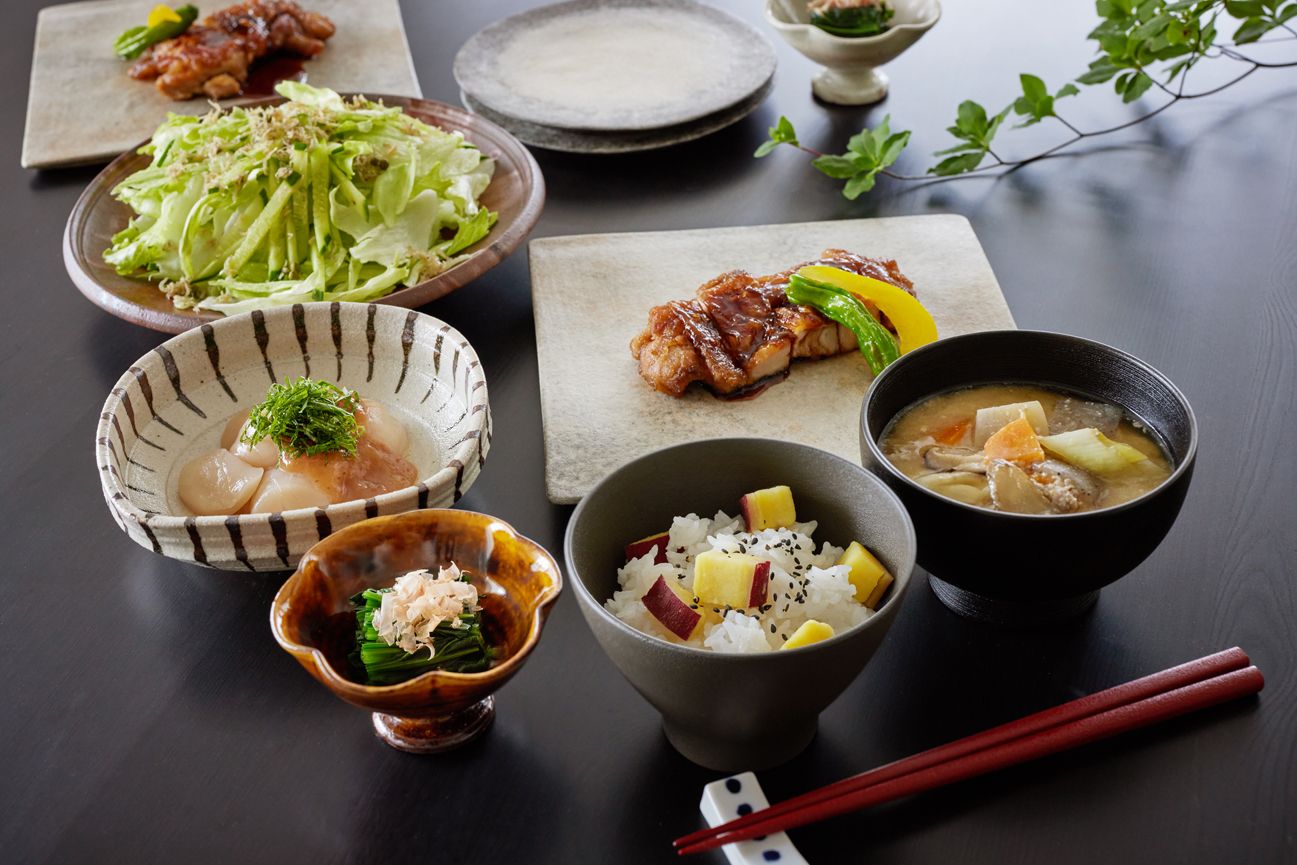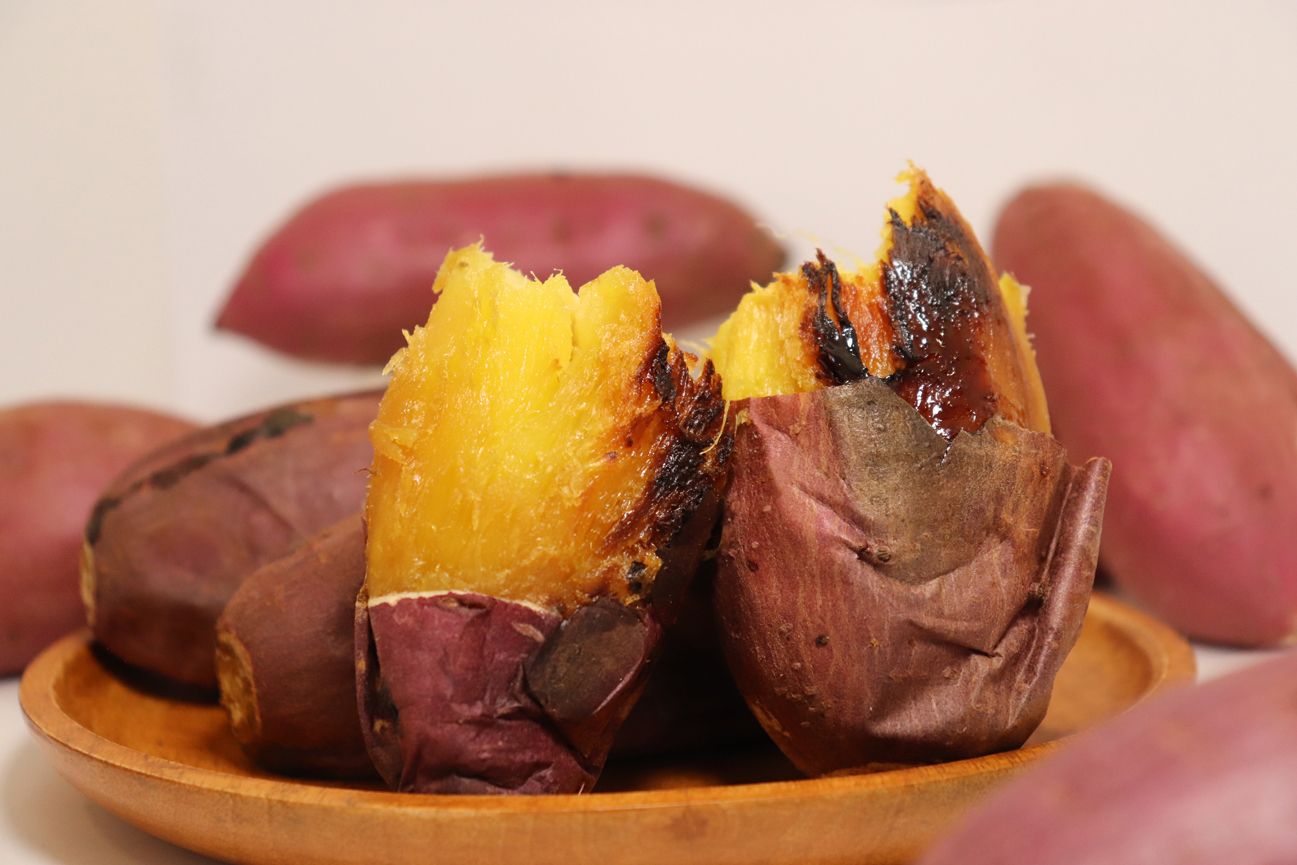
Sweet potatoes are being shipped from Miyazaki to all around the world. What makes them so enticing is the sheer number of varieties of sweetness and textures!
Southern Kyushu is rich in volcanic ash soil with good drainage, which makes it perfect for growing sweet potatoes. Within this region is Miyazaki Prefecture, and at the southernmost tip is Kushima City, which has long been known for its sweet potato production. Kushima City is home to Kushima Aoi Farm, one of the top agricultural companies in Japan in terms of annual shipments and exports. The company has focused on exports since its establishment, and President Mr. Yosuke Narasako wants the whole world to experience the deliciousness of Japanese sweet potatoes. Here, he tells us about the many initiatives he has been working on in this regard.
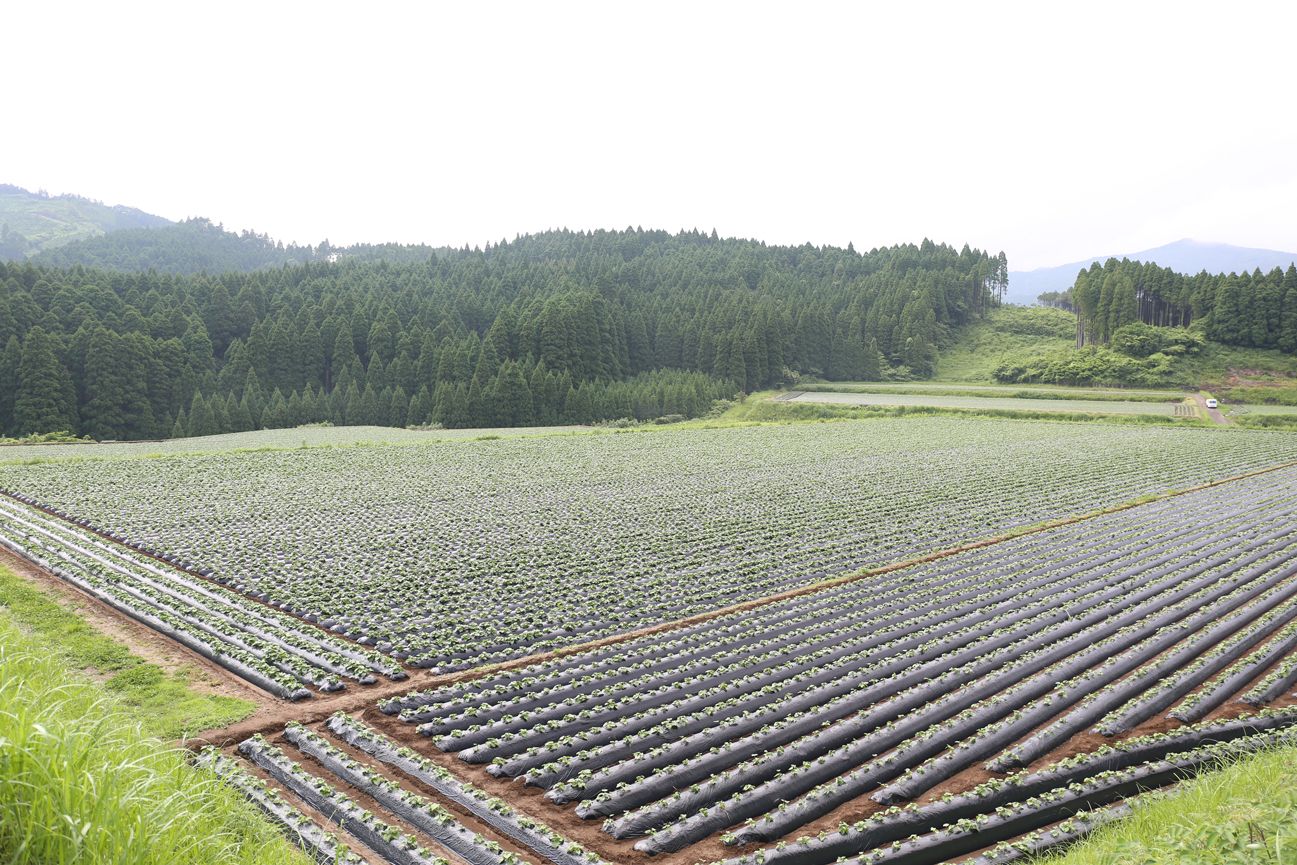
Kushima Aoi Farm spans an area of 45 hectares. Large farming areas are scarce in the hilly region of Kushima City, but Kushima Aoi Farm has established contracts with multiple farmers in order to increase the amount of produce it can handle.
The Japanese word for sweet potato is satsumaimo. Satsuma is the old name for Kagoshima (Miyazaki's neighboring prefecture), and imo means potato. They say it was originally introduced to Kagoshima from China via Okinawa in the early 16th century. Southern Kyushu, including the Kagoshima and Miyazaki regions, is one of the leading producers of sweet potato in Japan because sweet potatoes prefer well-drained soil, which the region has in abundance due to the ash and pebbles from ancient volcanic eruptions. Kushima Aoi Farm further improves its soil by turning the surface black soil with the underground red soil. The resulting soil is called akahoya, and it is great for growing because it has fewer natural pests.
Mr. Yosuke Narasako is the President of Kushima Aoi Farm, an agricultural venture born in Kushima City, Miyazaki Prefecture. The president at the time was originally a sweet potato farmer who founded the agricultural company in 2013 as a means to take on new challenges. Kushima Aoi Farm has attracted many young and highly motivated people with its grand idea of delivering the deliciousness of Japanese sweet potatoes to the world. Mr. Narasako is just one of those people.
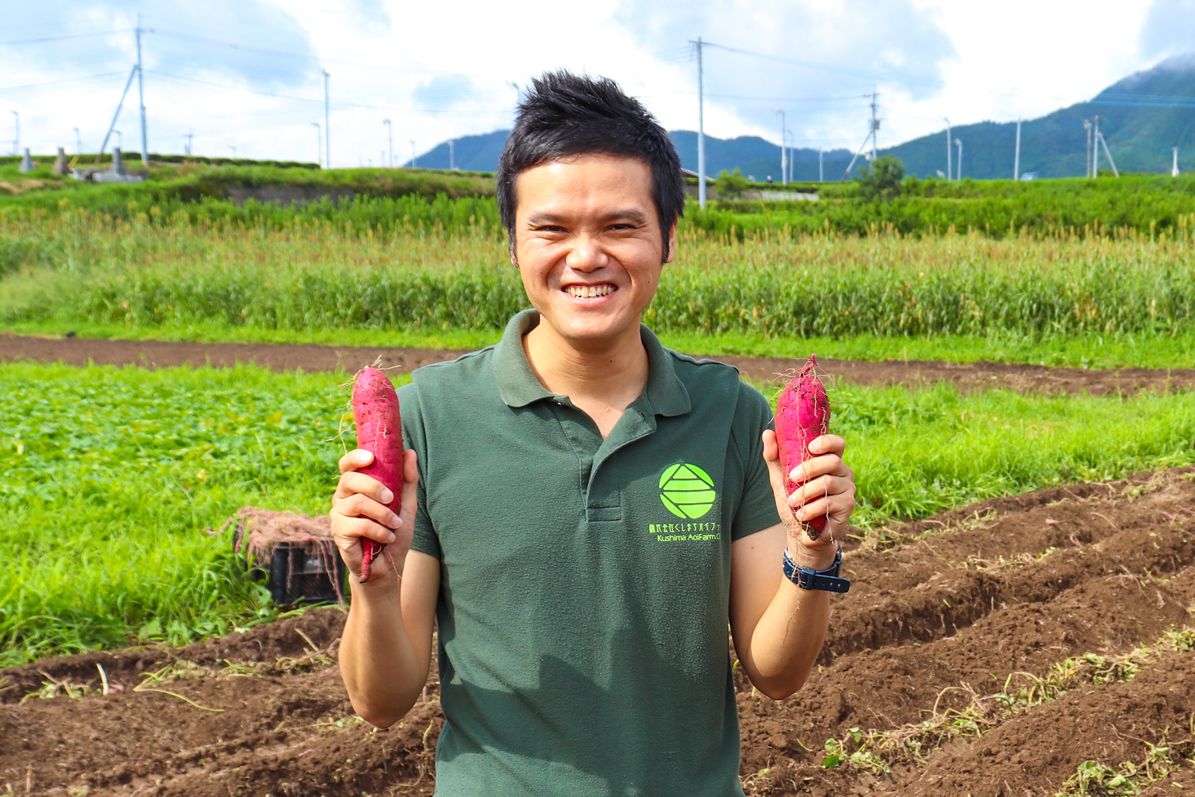
Mr. Narasako used to work for a trading company exporting sweet potatoes. Many of the workers at Kushima Aoi Farm are not from the local area, and the average age of the workers is 33, which is an unusually young age for an agricultural production company.
"Field research revealed that people in Southeast Asia like to steam sweet potatoes in rice cookers and so they prefer a smaller size," Mr. Narasako explains. "We also found that many local customers said that they are unable to eat an entire large sweet potato. Smaller-sized produce is often discarded as producers believe they won't sell, so I thought this would be a great opportunity for us."
In order to grow smaller-sized sweet potatoes for export, the company developed a unique method of "dense-hilled planting." By reducing the amount of space between seedlings and their hilled rows, they are able to harvest a large number of smaller-sized potatoes.
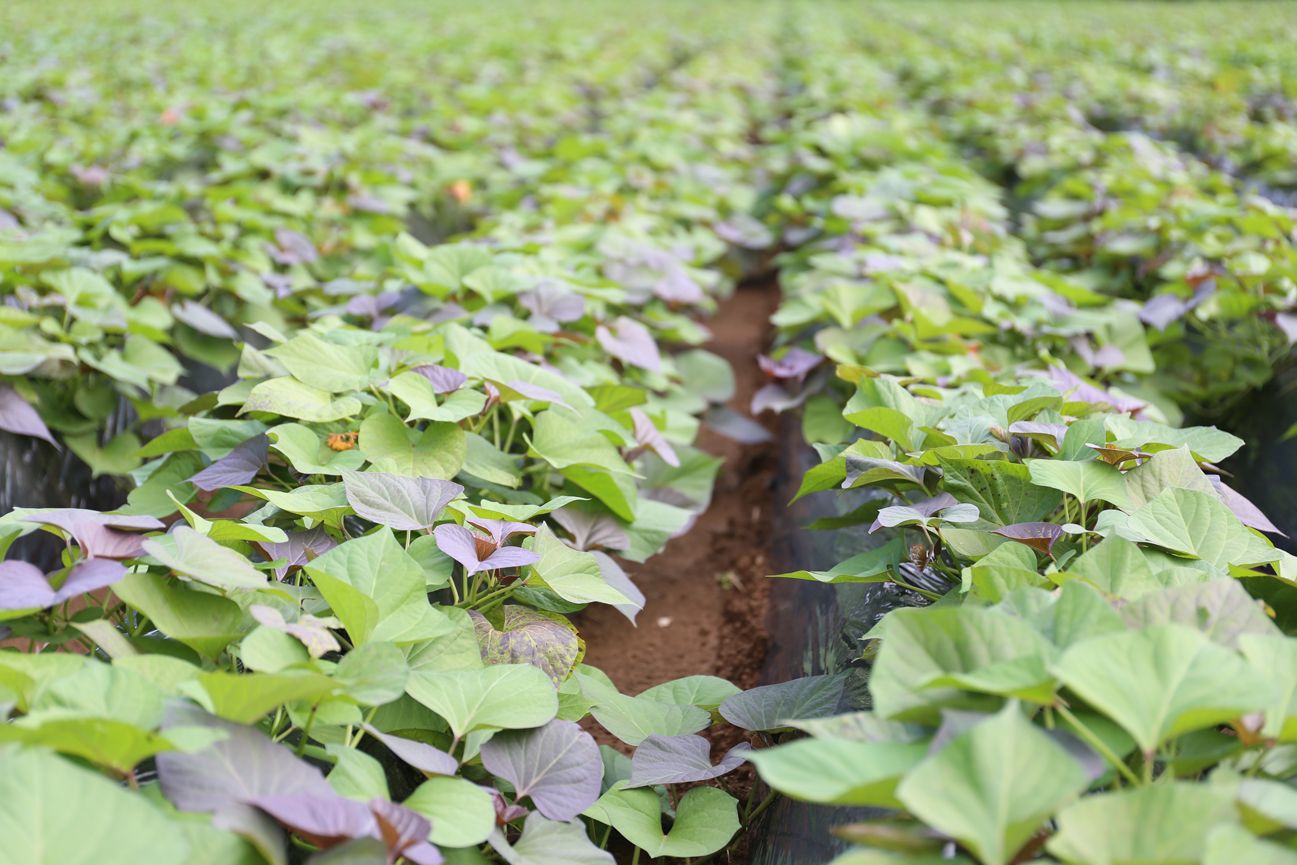
An abundance of sweet potato leaves growing in densely planted rows. The demand for a variety of sizes increased as sales channels expanded, so this method is no longer practiced.
The company has furthered its stable production system by increasing the number of endorsed contract farmers. It currently has contracts with about 230 farmers, and of the 8,200 tons of produce handled annually, 20% is exported internationally. It is one of the largest agricultural companies in Japan, and its strength lies in the fact that it not only handles production, but also the entire processing and sales process.
Kushima Aoi Farm is also rather particular about how it stores its sweet potatoes. Sweet potatoes are generally planted during April and May, and they are then harvested throughout September to November. The sweet potatoes are then cured in a storage facility to convert the starch into sugar for a sweeter potato. Kushima Aoi Farm installed one of the largest curing storage facilities in the country in 2016. "When you cure the sweet potatoes, you activate their ability to self-heal," says Mr. Narasako. "Leaving the potatoes in a hot and humid environment for a while causes a sort of cork layer to form over the damage caused by the harvest. This allows for long-term preservation."

A cork layer, almost like a "scab" in human terms, forms on the surface of the sweet potato after about 100 hours of exposure to 35°C temperatures and 100% humidity. The curing storage facility has a capacity of 250 tons.
The potatoes are then transferred to a temperature-controlled storage facility with a temperature of 13-15°C and 100% humidity where they are cured for at least two months before being shipped out sequentially. The shipping facility is a one-stop shop for washing, drying, and packaging, and it can ship 20 tons per day.
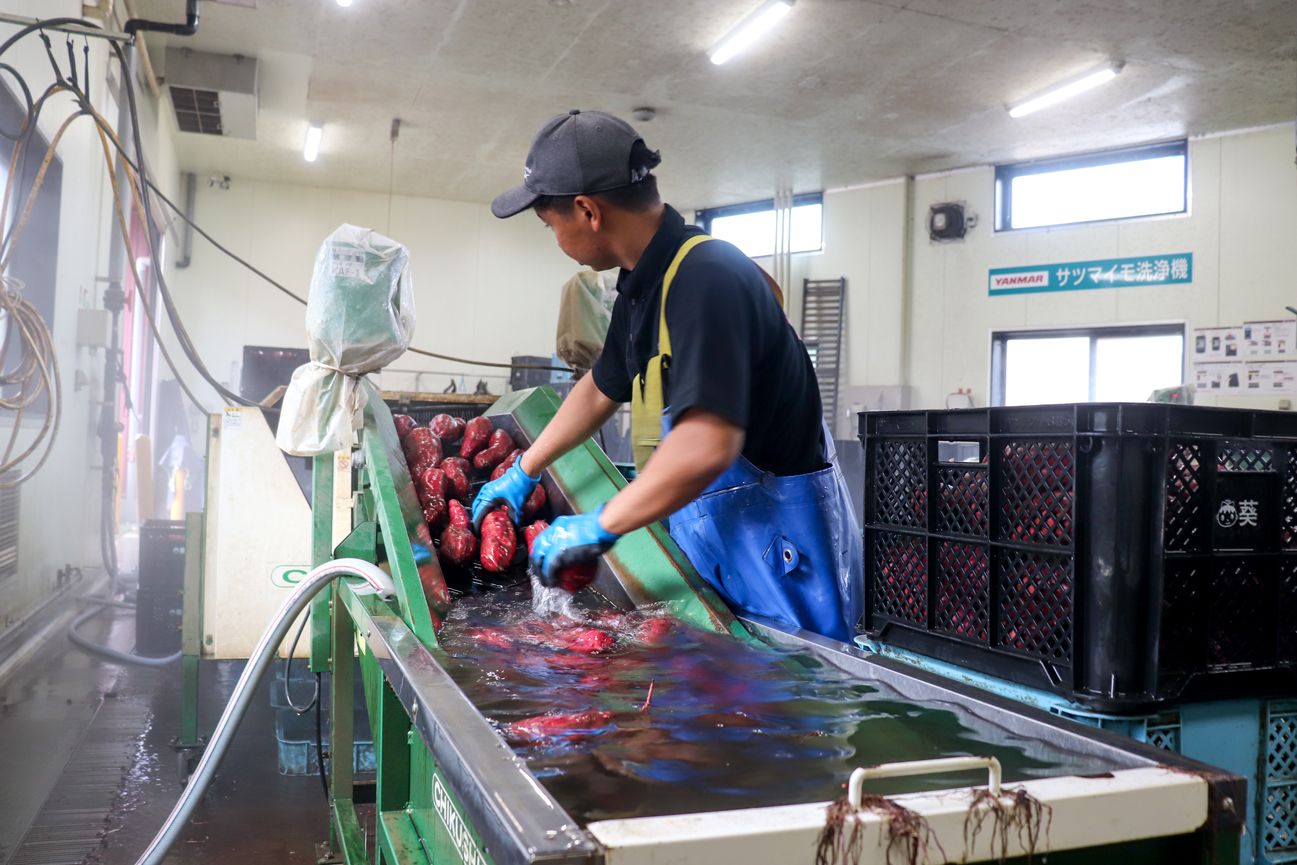
The sweet potatoes are roughly washed in a large tank of water at the washing station to remove most of the remaining soil. The staff then check each individual potato before sending them off on a conveyor belt to the washing machine.
Kushima Aoi Farm gradually increased the number of varieties of sweet potato it can handle in response to requests from supermarkets and other retailers. Now, its ability to handle such a wide variety, including the Miyazaki Beni variety, makes it unique. It can also differentiate the potatoes through unique naming and branding.
Mr. Narasako says the company currently deals with five main varieties. The Miyazaki Beni has a purple skin and yellow flesh. It has a soft and flaky texture, which makes it suitable for baking as well as for tempura. Then there's the Beni Haruka, which has seen a boom in popularity in the last few years. It has the same purple skin and yellow flesh, but it has a stickier texture, is much sweeter, and is perfect for baking. Another driving force behind the popularity of baked sweet potatoes is the Anno variety. Its skin is light orange, the flesh is orange, and it is sticky and sweet. Next, the Silk Sweet potato has a purple skin and yellow flesh, and it is so silky smooth when baked that you can eat it with a spoon. It's not too sweet, so everyone can enjoy it. Finally, the Purple Sweet Road is purple on the inside and on the outside, and it is refreshingly sweet. It is rich in anthocyanins, which is gaining attention in the cosmetics field.
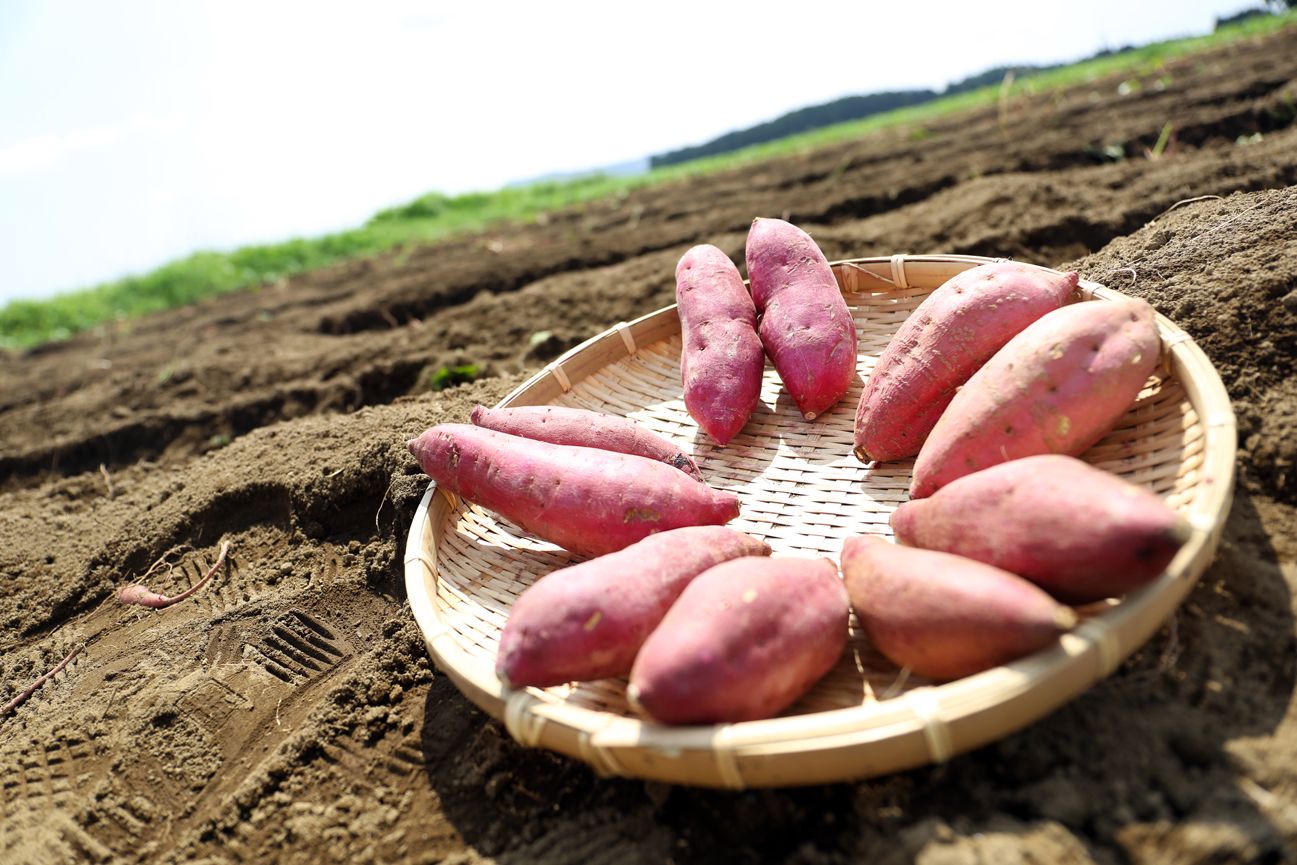
Five sweet potato varieties in a basket. Clockwise starting from the back: Purple Sweet Road, Anno, Miyazaki Beni, Silk Sweet, and Beni Haruka. Try them all, and compare their taste and textures.
In recent times, Kushima Aoi Farm has been actively producing a variety called the Beni Masari. Sweet potato disease was epidemic a few years back and there was no specific remedy for it, but through the course of trial and error, the company discovered a variety that was resistant to this disease. The new variety is characterized by its gentle texture and refined sweetness. However, Mr. Narasako says that just because something is disease-resistant for now, it doesn't mean it will continue to be disease-resistant into the future, which is why they are working with the University of Miyazaki to develop even more disease-resistant varieties.

The Beni Masari is the parent variety of the Silk Sweet potato. YosukeMr. Narasako says it has a similar texture and sweetness compared to the Silk Sweet, but with a beautiful amber color when you bake it and crumble it up.
Kushima Aoi Farm has always been eager to expand its business overseas ever since its establishment, and it has widely promoted the delicious taste of Japanese sweet potatoes. It is currently focusing on exports to Greater China and Southeast Asia, and each country has its own particular taste that it prefers.
Mr. Narasako says that Taiwanese sweet potatoes are round and have a sticky texture on the inside, so the slender and crumbly Miyazaki Beni variety is very popular. He also says that sweet potatoes are usually steamed in Asian cultures, but baked sweet potato has been gaining traction recently. As for which variety is the most popular, Mr. Narasako tells us, "Most all varieties are popular in Hong Kong and Singapore, while the large-sized Beni Haruka is the most popular variety in Thailand and Malaysia. But no matter which country we export to, they all say that Japanese sweet potatoes are by far the sweetest and most delicious."
Mr. Narasako has eaten his fair share of sweet potatoes from all around the world, and even he agrees that foreign sweet potatoes are not very sweet, so he understands why Japanese sweet potatoes are so well received. It is surely the result of the many years Japanese people have spent on developing breeds, as well as the curing techniques that have been honed and perfected by producers like Kushima Aoi Farm.
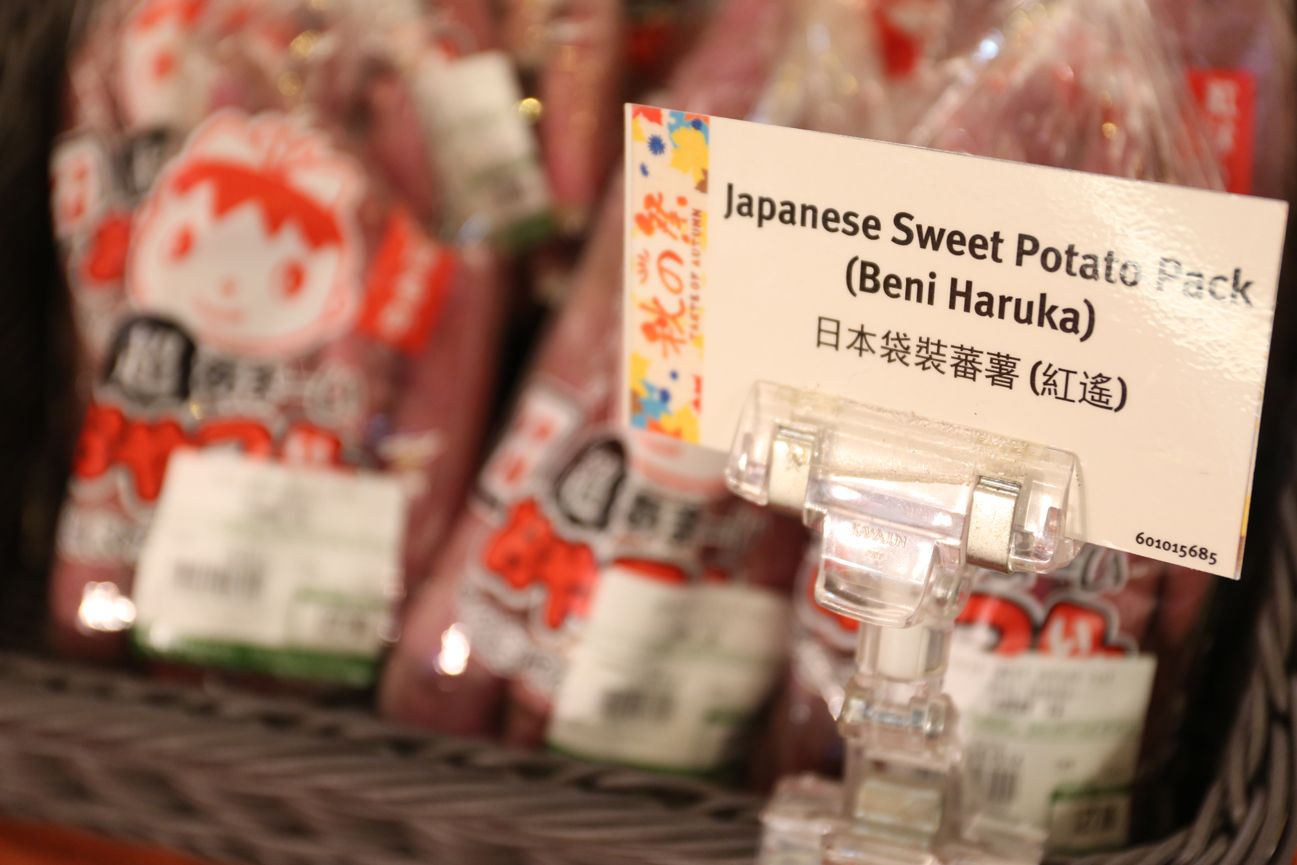
Packages of small Beni Haruka sweet potatoes in a Hong Kong supermarket. The girl's face on the packaging is the company's mascot "Aoi-chan," and she is recognized by people around the world.
Of course sweet potatoes can be simply steamed or baked, but they are also delicious in miso soup, a Japanese dish that is prevalent in the Asian region. Simply cut the sweet potato into half moon slices with the skin still on, soak them in water for 10 minutes to remove any impurities, then simmer in a broth until easily skewered. Finally, dissolve the miso paste into the broth and season to taste.
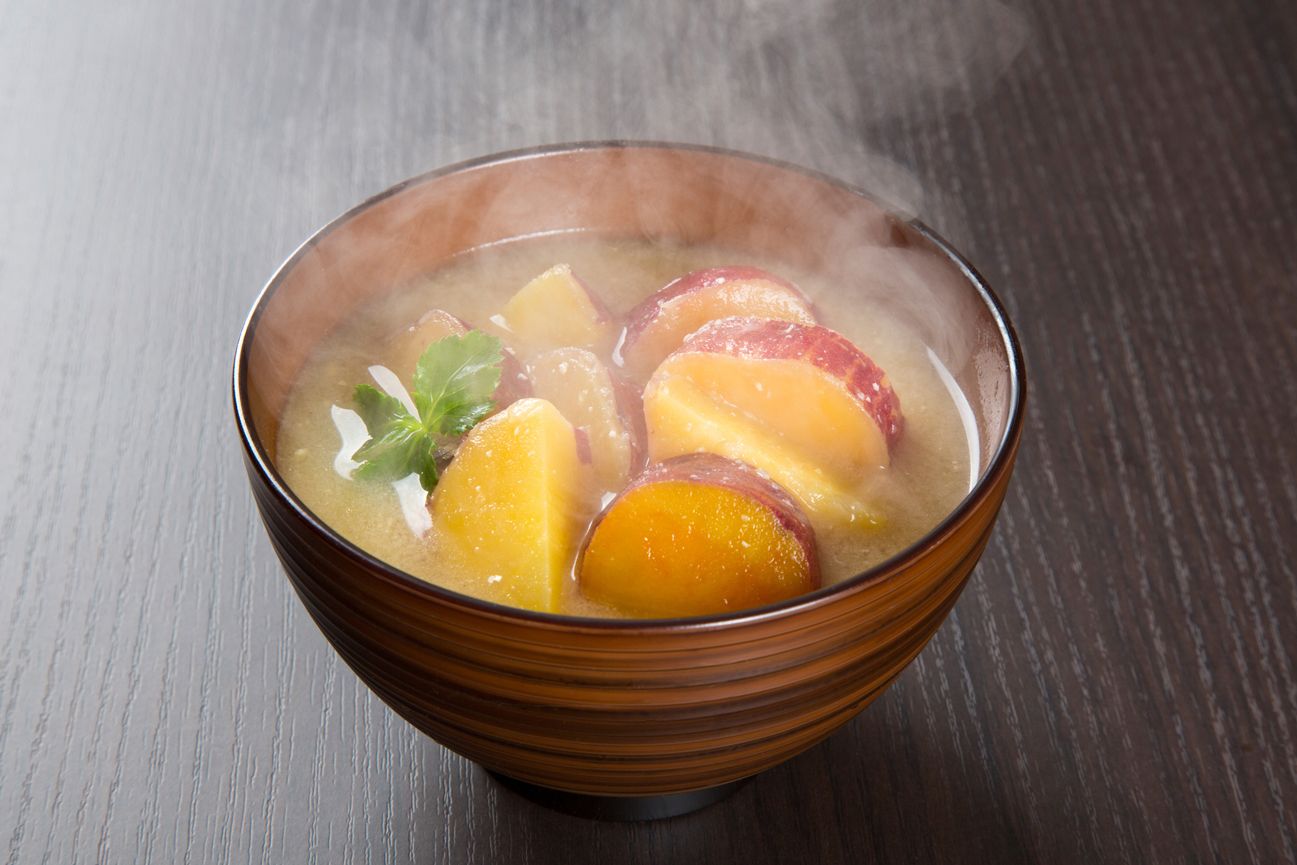
Mr. Narasako's recommended Japanese sweet potato miso soup. You can also add thinly-sliced onions or bite-sized pieces of cabbage to the miso soup to bring out the natural sweetness of the sweet potatoes.
Sweet potato tempura is popular and it can be prepared in the traditional method of dipping in batter and deep frying, but frozen baked sweet potato has also become quite popular in Japan these days. Kushima Aoi Farm has created its own product line, and the response has been strong during the summer months. The texture of a baked sweet potato is very mellow once it's been chilled and thawed, and it makes for a satisfying dessert. You can also slice it up and serve it with ice cream for an even more luxurious experience.
Mr. Narasako says that the company will continue exporting fresh sweet potato, but they will also focus on exporting processed products in the hopes that people will be able to enjoy all the different tastes of sweet potatoes.
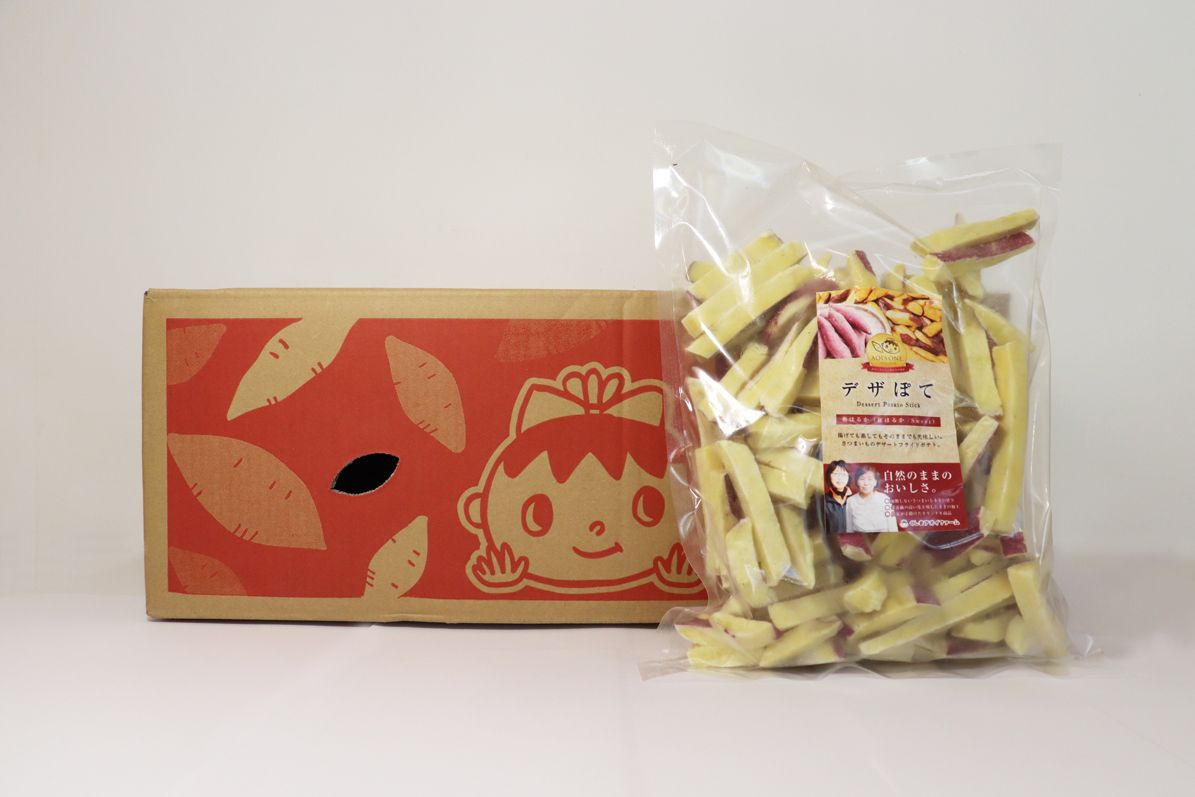
"Deza Pote" exported to North America. It is a frozen, deep fried French fry sweet potato product. They can be defrosted and eaten as is, or reheated in the microwave.
Kushima Aoi Farm is also actively working toward reducing food waste. The company teamed up with a materials manufacturer to develop a unique anti-condensation film to protect the produce from condensation during cargo exports, thereby reducing mold and food spoilage. The result was a significant decrease in the amount of food waste. The company also uses potatoes that are too big for sale in other products such as sweets and, in the future, it hopes to use the nutritious vines to develop supplements, and also generate biomass energy from damaged potatoes.

Seedlings being planted. The company used to dispose of its sheet mulching to prevent disease, but it is now switching to biodegradable mulching that decomposes into the soil in an effort to achieve SDG targets.
Mr. Narasako says, "I want more and more people to be able to enjoy delicious Japanese sweet potatoes. I don't want to just export them overseas, I want the locals to enjoy them too." One bite of that enveloping sweetness is sure to bring a smile to people all around the world.
◎Click here for Japanese sweet potato recipes.
Pork and Vegetable Miso Soup
Sweet Potato and Rice-flour Dumpling Soup
Reference: Japan Fruit and Vegetables Export Promotion Council
Photos supplied by: Kushima Aoi Farm
Text: Yukiko Takase
Kushima City, Miyazaki Prefecture
Kushima Aoi Farm
Mr. Makoto Ikeda is a fourth-generation sweet potato farmer. With hopes of becoming a dependable farmer, he founded the company in 2013. The company has now grown to include 111 staff, including part-time workers, and has contracts with 230 farmers. With sales for the 2022 fiscal year totaling 1.923 billion yen, and handling 8,200 tons of produce, it is one of Japan's top agricultural corporations. The company has been exporting to Hong Kong, Taiwan, Singapore, and other Asian countries since its establishment, and it hopes to expand to the Middle East, Europe, and North America in the future.
https://aoifarm-gr.com/






